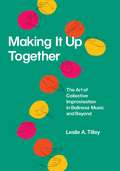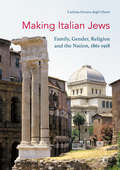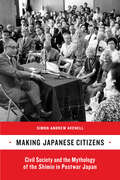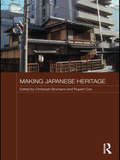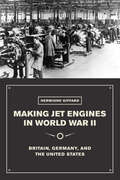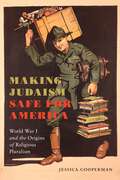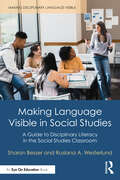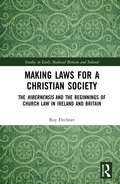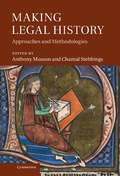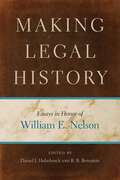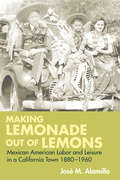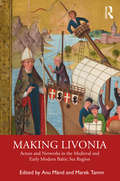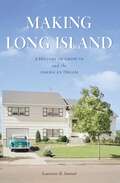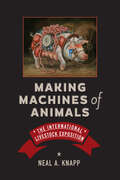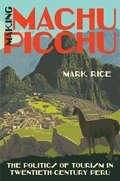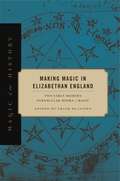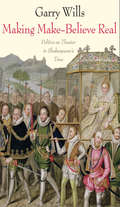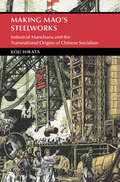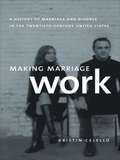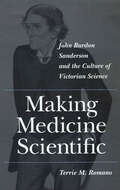- Table View
- List View
Making It Up Together: The Art of Collective Improvisation in Balinese Music and Beyond (Chicago Studies in Ethnomusicology)
by Leslie A. TilleyMost studies of musical improvisation focus on individual musicians. But that is not the whole story. From jazz to flamenco, Shona mbira to Javanese gamelan, improvised practices thrive on group creativity, relying on the close interaction of multiple simultaneously improvising performers. In Making It Up Together, Leslie A. Tilley explores the practice of collective musical improvisation cross-culturally, making a case for placing collectivity at the center of improvisation discourse and advocating ethnographically informed music analysis as a powerful tool for investigating improvisational processes. Through two contrasting Balinese case studies—of the reyong gong chime’s melodic norot practice and the interlocking drumming tradition kendang arja—Tilley proposes and tests analytical frameworks for examining collectively improvised performance. At the micro-level, Tilley’s analyses offer insight into the note-by-note decisions of improvising performers; at the macro-level, they illuminate larger musical, discursive, structural, and cultural factors shaping those decisions. This multi-tiered inquiry reveals that unpacking how performers play and imagine as a collective is crucial to understanding improvisation and demonstrates how music analysis can elucidate these complex musical and interactional relationships. Highlighting connections with diverse genres from various music cultures, Tilley’s examinations of collective improvisation also suggest rich potential for cross-genre exploration. The surrounding discussions point to larger theories of communication and interaction, creativity and cognition that will be of interest to a range of readers—from ethnomusicologists and music theorists to cognitive psychologists, jazz studies scholars, and improvising performers. Setting new parameters for the study of improvisation, Making It Up Together opens up fresh possibilities for understanding the creative process, in music and beyond.
Making It Up Together: The Art of Collective Improvisation in Balinese Music and Beyond (Chicago Studies in Ethnomusicology)
by Leslie A. TilleyMost studies of musical improvisation focus on individual musicians. But that is not the whole story. From jazz to flamenco, Shona mbira to Javanese gamelan, improvised practices thrive on group creativity, relying on the close interaction of multiple simultaneously improvising performers. In Making It Up Together, Leslie A. Tilley explores the practice of collective musical improvisation cross-culturally, making a case for placing collectivity at the center of improvisation discourse and advocating ethnographically informed music analysis as a powerful tool for investigating improvisational processes. Through two contrasting Balinese case studies—of the reyong gong chime’s melodic norot practice and the interlocking drumming tradition kendang arja—Tilley proposes and tests analytical frameworks for examining collectively improvised performance. At the micro-level, Tilley’s analyses offer insight into the note-by-note decisions of improvising performers; at the macro-level, they illuminate larger musical, discursive, structural, and cultural factors shaping those decisions. This multi-tiered inquiry reveals that unpacking how performers play and imagine as a collective is crucial to understanding improvisation and demonstrates how music analysis can elucidate these complex musical and interactional relationships. Highlighting connections with diverse genres from various music cultures, Tilley’s examinations of collective improvisation also suggest rich potential for cross-genre exploration. The surrounding discussions point to larger theories of communication and interaction, creativity and cognition that will be of interest to a range of readers—from ethnomusicologists and music theorists to cognitive psychologists, jazz studies scholars, and improvising performers. Setting new parameters for the study of improvisation, Making It Up Together opens up fresh possibilities for understanding the creative process, in music and beyond.
Making Italian Jews
by Carlotta Ferrara degli UbertiThis book depicts the cultural imagination of the Italian-Jewish minority from the unification of the country to the end of the First World War. The creation of an Italian nation-state introduced new problems and new opportunities for its citizens. What did it mean for the Jewish minority? How could members of the minority combine and redefine Jewishness and Italianness in a radically new political and legal framework? Key concepts such as family, religion, nation, assimilation and - later - Zionism are observed as they shift and change over time. The interaction between the public and private spheres plays a pivotal role in the analysis, and the self-fashioning of Italian Jewish #65533;lites is read alongside the evolution of the cultural stereotypes typical of the time. Reinterpreting the Italian national patriotic narrative through the eyes of the Jews, Carlotta Ferrara degli Uberti is able to unveil its less known layers and articulations, while at the same time offering a new perspective from which to read the modern Jewish experience in the Western World.
Making Japanese Citizens: Civil Society and the Mythology of the <i>Shimin</i> in Postwar Japan
by Simon Andrew AvenellMaking Japanese Citizens is an expansive history of the activists, intellectuals, and movements that played a crucial role in shaping civil society and civic thought throughout the broad sweep of Japan's postwar period. Weaving his analysis around the concept of shimin (citizen), Simon Avenell traces the development of a new vision of citizenship based on political participation, self-reliance, popular nationalism, and commitment to daily life. He traces civic activism through six phases: the cultural associations of the 1940s and 1950s, the massive U.S.-Japan Security Treaty protests of 1960, the anti-Vietnam War movement, the antipollution and antidevelopment protests of the 1960s and 1970s, movements for local government reform and the rise of new civic groups from the mid-1970s. This rich portrayal of activists and their ideas illuminates questions of democracy, citizenship, and political participation both in contemporary Japan and in other industrialized nations more generally.
Making Japanese Heritage (Japan Anthropology Workshop Series)
by Christoph BrumannThis book examines the making of heritage in contemporary Japan, investigating the ways in which particular objects, practices and institutions are ascribed public recognition and political significance. Through detailed ethnographic and historical case studies, it analyses the social, economic, and even global political dimensions of cultural heritage. It shows how claims to heritage status in Japan stress different material qualities of objects, places and people - based upon their ages, originality and usage. Following on an introduction that thoroughly assesses the field, the ethnographic and historiographic case studies range from geisha; noh masks; and the tea ceremony; urban architecture; automata; a utopian commune and the sites of Mitsubishi company history. They examine how their heritage value is made and re-made, and appraise the construction of heritage in cases where the heritage value resides in the very substance of the object’s material composition - for example, in architecture, landscapes and designs - and show how the heritage industry adds values to existing assets: such as sacredness, urban charm or architectural and ethnic distinctiveness. The book questions the interpretation of material heritage as an enduring expression of social relations, aesthetic values and authenticity which, once conferred, undergoes no subsequent change, and standard dismissals of heritage as merely a tool for enshrining the nation; supporting the powerful; fostering nostalgic escapism; or advancing capitalist exploitation. Finally, it considers the role of people as agents of heritage production, and analyses the complexity of the relationships between people and objects. This book is a rigorous assessment of how conceptions of Japanese heritage have been forged, and provides a wealth of evidence that questions established assumptions on the nature and social roles of heritage.
Making Jet Engines in World War II: Britain, Germany, and the United States
by Hermione GiffardOur stories of industrial innovation tend to focus on individual initiative and breakthroughs. With Making Jet Engines in World War II, Hermione Giffard uses the case of the development of jet engines to offer a different way of understanding technological innovation, revealing the complicated mix of factors that go into any decision to pursue an innovative, and therefore risky technology. Giffard compares the approaches of Britain, Germany, and the United States. Each approached jet engines in different ways because of its own war aims and industrial expertise. Germany, which produced more jet engines than the others, did so largely as replacements for more expensive piston engines. Britain, on the other hand, produced relatively few engines--but, by shifting emphasis to design rather than production, found itself at war's end holding an unrivaled range of designs. The US emphasis on development, meanwhile, built an institutional basis for postwar production. Taken together, Giffard's work makes a powerful case for a more nuanced understanding of technological innovation, one that takes into account the influence of the many organizational factors that play a part in the journey from idea to finished product.
Making Judaism Safe for America: World War I and the Origins of Religious Pluralism (Religion and Social Transformation #4)
by Jessica CoopermanHonorable Mention, 2019 Saul Viener Book Prize, given by the American Jewish Historical SocietyA compelling story of how Judaism became integrated into mainstream American religion In 1956, the sociologist Will Herberg described the United States as a “triple-melting pot,” a country in which “three religious communities - Protestant, Catholic, Jewish – are America.” This description of an American society in which Judaism and Catholicism stood as equal partners to Protestantism begs explanation, as Protestantism had long been the dominant religious force in the U.S. How did Americans come to embrace Protestantism, Catholicism, and Judaism as “the three facets of American religion?”Historians have often turned to the experiences of World War II in order to explain this transformation. However, World War I’s impact on changing conceptions of American religion is too often overlooked. This book argues that World War I programs designed to protect the moral welfare of American servicemen brought new ideas about religious pluralism into structures of the military. Jessica Cooperman shines a light on how Jewish organizations were able to convince both military and civilian leaders that Jewish organizations, alongside Christian ones, played a necessary role in the moral and spiritual welfare of America’s fighting forces. This alone was significant, because acceptance within the military was useful in modeling acceptance in the larger society. The leaders of the newly formed Jewish Welfare Board, which became the military’s exclusive Jewish partner in the effort to maintain moral welfare among soldiers, used the opportunities created by war to negotiate a new place for Judaism in American society. Using the previously unexplored archival collections of the JWB, as well as soldiers’ letters, memoirs and War Department correspondence, Jessica Cooperman shows that the Board was able to exert strong control over expressions of Judaism within the military. By introducing young soldiers to what it saw as appropriately Americanized forms of Judaism and Jewish identity, the JWB hoped to prepare a generation of American Jewish men to assume positions of Jewish leadership while fitting comfortably into American society.This volume shows how, at this crucial turning point in world history, the JWB managed to use the policies and power of the U.S. government to advance its own agenda: to shape the future of American Judaism and to assert its place as a truly American religion.
Making Language Visible in Social Studies: A Guide to Disciplinary Literacy in the Social Studies Classroom (Making Disciplinary Language Visible)
by Ruslana Westerlund Sharon BesserAs the first book in the Making Disciplinary Language Visible series, this practical toolkit helps teachers promote disciplinary literacy development for Multilingual learners and their peers in the 5–12 social studies classroom. Using systemic functional linguistics (SFL) and the SFL-informed genre pedagogy, the Teaching and Learning Cycle for Disciplinary Genres, the book shows teachers how to teach content using language as a meaning-making resource. Besser and Westerlund provide clear guidance on understanding how language is used in the discipline and provide practical tools to empower teachers to teach language in the service of social studies disciplinary genres. Chapters feature authentic vignettes to illustrate problems of practice, annotated social studies texts, practical curriculum design tools, exercises for readers to develop knowledge about language, and sample scripts for practical application.
Making Laws for a Christian Society: The Hibernensis and the Beginnings of Church Law in Ireland and Britain (Studies in Early Medieval Britain and Ireland)
by Roy FlechnerThis is the first comprehensive study of the contribution that texts from Britain and Ireland made to the development of canon law in early medieval Europe. The book concentrates on a group of insular texts of church law—chief among them the Irish Hibernensis—tracing their evolution through mutual influence, their debt to late antique traditions from around the Mediterranean, their reception (and occasional rejection) by clerics in continental Europe, their fusion with continental texts, and their eventual impact on the formation of a European canonical tradition. Canonical collections, penitentials, and miscellanies of church law, and royal legislation, are all shown to have been 'living texts', which were continually reshaped through a process of trial and error that eventually gave rise to a more stable and more coherent body of church laws. Through a meticulous text-critical study Roy Flechner argues that the growth of church law in Europe owes as much to a serendipitous 'conversation' between texts as it does to any deliberate plan overseen by bishops and popes.
Making Legal History
by Chantal Stebbings Anthony MussonDrawing together leading legal historians from a range of jurisdictions and cultures, this collection of essays addresses the fundamental methodological underpinning of legal history research. Via a broad chronological span and a wide range of topics, the contributors explore the approaches, methods and sources that together form the basis of their research and shed light on the complexities of researching into the history of the law. By exploring the challenges posed by visual, unwritten and quasi-legal sources, the difficulties posed by traditional archival material and the novelty of exploring the development of legal culture and comparative perspectives, the book reveals the richness and dynamism of legal history research.
Making Legal History: Essays in Honor of William E. Nelson
by William E. NelsonOne of the academy’s leading legal historians, William E. Nelson is the Edward Weinfeld Professor of Law at New York University School of Law. For more than four decades, Nelson has produced some of the most original and creative work on American constitutional and legal history. His prize-winning books have blazed new trails for historians with their substantive arguments and the scope and depth of Nelson’s exploration of primary sources. Nelson was the first legal scholar to use early American county court records as sources of legal and social history, and his work (on legal history in England, colonial America, and New York) has been a model for generations of legal historians. This book collects ten essays exemplifying and explaining the process of identifying and interpreting archival sources—the foundation of an array of methods of writing American legal history. The essays presented here span the full range of American history from the colonial era to the 1980s.Each historian has either identified a body of sources not previously explored or devised a new method of interrogating sources already known.The result is a kaleidoscopic examination of the historian’s task and of the research methods and interpretative strategies that characterize the rich, complex field of American constitutional and legal history.
Making Lemonade out of Lemons: Mexican American Labor and Leisure in a California Town 1880-1960 (Statue of Liberty Ellis Island)
by José M. AlamilloOut of the “lemons” handed to Mexican American workers in Corona, California--low pay, segregated schooling, inadequate housing, and racial discrimination--Mexican men and women made “lemonade” by transforming leisure spaces such as baseball games, parades, festivals, and churches into politicized spaces where workers voiced their grievances, debated strategies for advancement, and built solidarity. Using oral history interviews, extensive citrus company records, and his own experiences in Corona, José Alamillo argues that Mexican Americans helped lay the groundwork for civil rights struggles and electoral campaigns in the post-World War II era.
Making Livonia: Actors and Networks in the Medieval and Early Modern Baltic Sea Region
by Marek Tamm Anu MändThe region called Livonia (corresponding to modern Estonia and Latvia) emerged out of the rapid transformation caused by the conquest, Christianisation and colonisation on the north-east shore of the Baltic Sea in the late twelfth and the early thirteenth centuries. These radical changes have received increasing scholarly notice over the last few decades. However, less attention has been devoted to the interplay between the new and the old structures and actors in a longer perspective. This volume aims to study these interplays and explores the history of Livonia by concentrating on various actors and networks from the late twelfth to the seventeenth century. But, on a deeper level, the goal is more ambitious: to investigate the foundation of an increasingly complex and heterogeneous society on the medieval and early modern Baltic frontier – ‘the making of Livonia’.
Making Long Island: A History of Growth and the American Dream (The History Press)
by Lawrence R. SamuelDiscover the history of the development of Long Island and its intimate relationship with New York City. Beginning in the Roaring Twenties, Wall Street money looked eastward to Nassau and Suffolk counties looking generate wealth from a land boom. After the Great Depression and World War II, Long Island was the site of the creation of the quintessential postwar American suburb, Levittown. Levittown and its spinoff suburban communities served as a primary symbol of the American dream through affordable home ownership for the predominately White middle class and established a core attribute of the national mythology. Starting in the 1960s, the dream began to dissolve, as the postwar economic engine ran out of steam and Long Island became as much urban as suburban. Author Lawrence R. Samuel charts how the island evolved over the decades and largely detached itself from New York City to become a self-sustaining entity with its own challenges, exclusions and triumphs.
Making Love in the Twelfth Century: "Letters of Two Lovers" in Context
by Barbara NewmanNine hundred years ago in Paris, a teacher and his brilliant female student fell in love and chronicled their affair in a passionate correspondence. Their 116 surviving letters, some whole and some fragmentary, are composed in eloquent, highly rhetorical Latin. Since their discovery in the late twentieth century, the Letters of Two Lovers have aroused much attention because of their extreme rarity. They constitute the longest correspondence by far between any two persons from the entire Middle Ages, and they are private rather than institutional--which means that, according to all we know about the transmission of medieval letters, they should not have survived at all. Adding to their mystery, the letters are copied anonymously in a single late fifteenth-century manuscript, although their style and range of reference place them squarely in the early twelfth century.Can this collection of correspondence be the previously lost love letters of Abelard and Heloise? And even if not, what does it tell us about the lived experience of love in the twelfth century?Barbara Newman contends that these teacher-student exchanges bear witness to a culture that linked Latin pedagogy with the practice of ennobling love and the cult of friendship during a relatively brief period when women played an active part in that world. Newman presents a new translation of these extraordinary letters, along with a full commentary and two extended essays that parse their literary and intellectual contexts and chart the course of the doomed affair. Included, too, are two other sets of twelfth-century love epistles, the Tegernsee Letters and selections from the Regensburg Songs. Taken together, they constitute a stunning contribution to the study of the history of emotions by one of our most prominent medievalists.
Making Machines of Animals: The International Livestock Exposition (Animals, History, Culture)
by Neal A. KnappHow the Chicago International Livestock Exposition leveraged the eugenics movement to transform animals into machines and industrialize American agriculture.In 1900, the Chicago International Livestock Exposition became the epicenter of agricultural reform that focused on reinventing animals' bodies to fit a modern, industrial design. Chicago meatpackers partnered with land-grant university professors to create the International—a spectacle on the scale of a world's fair—with the intention of setting the standard for animal quality and, in doing so, transformed American agriculture.In Making Machines of Animals, Neal A. Knapp explains the motivations of both the meatpackers and the professors, describing how they deployed the International to redefine animality itself. Both professors and packers hoped to replace so-called scrub livestock with "improved" animals and created a new taxonomy of animal quality based on the burgeoning eugenics movement. The International created novel definitions of animal superiority and codified new norms, resulting in a dramatic shift in animal weight, body size, and market age. These changes transformed the animals from multipurpose to single-purpose products. These standardized animals and their dependence on off-the-farm inputs and exchanges limited farmer choices regarding husbandry and marketing, ultimately undermining any goals for balanced farming or the maintenance and regeneration of soil fertility.Drawing on land-grant university research and publications, meatpacker records and propaganda, and newspaper and agricultural journal articles, Knapp critiques the supposed market-oriented, efficiency-driven industrial reforms proffered by the International, which were underpinned by irrational, racist ideologies. The livestock reform movement not only resulted in cruel and violent outcomes for animals but also led to twentieth-century crops and animal husbandry that were rife with inefficiencies and agricultural vulnerabilities.
Making Machu Picchu: The Politics of Tourism in Twentieth-Century Peru
by Mark RiceSpeaking at a 1913 National Geographic Society gala, Hiram Bingham III, the American explorer celebrated for finding the "lost city" of the Andes two years earlier, suggested that Machu Picchu "is an awful name, but it is well worth remembering." Millions of travelers have since followed Bingham's advice. When Bingham first encountered Machu Picchu, the site was an obscure ruin. Now designated a UNESCO World Heritage Site, Machu Picchu is the focus of Peru's tourism economy. Mark Rice's history of Machu Picchu in the twentieth century—from its "discovery" to today's travel boom—reveals how Machu Picchu was transformed into both a global travel destination and a powerful symbol of the Peruvian nation.Rice shows how the growth of tourism at Machu Picchu swayed Peruvian leaders to celebrate Andean culture as compatible with their vision of a modernizing nation. Encompassing debates about nationalism, Indigenous peoples' experiences, and cultural policy—as well as development and globalization—the book explores the contradictions and ironies of Machu Picchu's transformation. On a broader level, it calls attention to the importance of tourism in the creation of national identity in Peru and Latin America as a whole.
Making Magic in Elizabethan England: Two Early Modern Vernacular Books of Magic (Magic in History)
by Frank KlaassenThis volume presents editions of two fascinating anonymous and untitled manuscripts of magic produced in Elizabethan England: the Antiphoner Notebook and the Boxgrove Manual. Frank Klaassen uses these texts, which he argues are representative of the overwhelming majority of magical practitioners, to explain how magic changed during this period and why these developments were crucial to the formation of modern magic.The Boxgrove Manual is a work of learned ritual magic that synthesizes material from Henry Cornelius Agrippa, the Fourth Book of Occult Philosophy, Heptameron, and various medieval conjuring works. The Antiphoner Notebook concerns the common magic of treasure hunting, healing, and protection, blending medieval conjuring and charm literature with materials drawn from Reginald Scot’s famous anti-magic work, Discoverie of Witchcraft. Klaassen painstakingly traces how the scribes who created these two manuscripts adapted and transformed their original sources. In so doing, he demonstrates the varied and subtle ways in which the Renaissance, the Reformation, new currents in science, the birth of printing, and vernacularization changed the practice of magic.Illuminating the processes by which two sixteenth-century English scribes went about making a book of magic, this volume provides insight into the wider intellectual culture surrounding the practice of magic in the early modern period.
Making Magic in Elizabethan England: Two Early Modern Vernacular Books of Magic (Magic in History)
by Frank KlaassenThis volume presents editions of two fascinating anonymous and untitled manuscripts of magic produced in Elizabethan England: the Antiphoner Notebook and the Boxgrove Manual. Frank Klaassen uses these texts, which he argues are representative of the overwhelming majority of magical practitioners, to explain how magic changed during this period and why these developments were crucial to the formation of modern magic.The Boxgrove Manual is a work of learned ritual magic that synthesizes material from Henry Cornelius Agrippa, the Fourth Book of Occult Philosophy, Heptameron, and various medieval conjuring works. The Antiphoner Notebook concerns the common magic of treasure hunting, healing, and protection, blending medieval conjuring and charm literature with materials drawn from Reginald Scot’s famous anti-magic work, Discoverie of Witchcraft. Klaassen painstakingly traces how the scribes who created these two manuscripts adapted and transformed their original sources. In so doing, he demonstrates the varied and subtle ways in which the Renaissance, the Reformation, new currents in science, the birth of printing, and vernacularization changed the practice of magic.Illuminating the processes by which two sixteenth-century English scribes went about making a book of magic, this volume provides insight into the wider intellectual culture surrounding the practice of magic in the early modern period.
Making Make-Believe Real
by Garry WillsShakespeare's plays abound with kings and leaders who crave a public stage and seize every opportunity to make their lives a performance: Antony, Cleopatra, Richard III, Othello, and many others. Such self-dramatizing characters appear in the work of other playwrights of the era as well, Marlowe's Edward II and Tamburlaine among them. But Elizabethan playwrights were not alone in realizing that a sense of theater was essential to the exercise of power. Real rulers knew it, too, and none better than Queen Elizabeth. In this fascinating study of political stagecraft in the Elizabethan era, Garry Wills explores a period of vast cultural and political change during which the power of make-believe to make power real was not just a theory but an essential truth. Wills examines English culture as Catholic Christianity's rituals were being overturned and a Protestant queen took the throne. New iconographies of power were necessary for the new Renaissance liturgy to displace the medieval church-state. The author illuminates the extensive imaginative constructions that went into Elizabeth's reign and the explosion of great Tudor and Stuart drama that provided the imaginative power to support her long and successful rule.
Making Mao's Steelworks: Industrial Manchuria and the Transnational Origins of Chinese Socialism (Cambridge Studies in the History of the People's Republic of China)
by Koji HirataLocated in Manchuria (Northeast China), the geopolitical borderland between China, Russia, and Japan, among others, Anshan Iron and Steel Works (Angang) was Mao-era China's most important industrial enterprise. The history of Angang from 1915 to 2000 reveals the hybrid nature of China's accelerated industrialization, shaped by transnational interactions, domestic factors, and local dynamics. Utilizing archives in Chinese, Japanese, Russian, and English, Koji Hirata provides the first comprehensive history of this enterprise before, during, and after the Mao era (1949–1976). Through this unique lens, he explores the complex interplay of transnational influences in Mao-era China. By illustrating the symbiotic relationship between socialism and capitalism during the twentieth century, this major new study situates China within the complex global history of late industrialization.
Making Marriage Work: A History of Marriage and Divorce in the Twentieth-Century United States
by Kristin CelelloBy the end of World War I, the skyrocketing divorce rate in the United States had generated a deep-seated anxiety about marriage. This fear drove middle-class couples to seek advice, both professional and popular, in order to strengthen their relationships. InMaking Marriage Work, historian Kristin Celello offers an insightful and wide-ranging account of marriage and divorce in America in the twentieth century, focusing on the development of the idea of marriage as "work. " Examining the marriage counseling profession, advice columns in women's magazines, movies, and television shows, Celello describes how professionals and the public worked together to define the nature of marital work throughout the twentieth century. She also demonstrates that the maxim of "working at marriage" often masked important inequalities in regard to men's and women's roles within marriage. Most experts, for instance, assumed that women needed marriage more than men and thus held wives accountable for marital success or failure. Making Marriage Workpresents a new interpretation of married life in the United States, illuminating the interaction of marriage and divorce over the century and revealing how the idea that marriage requires work became part of Americans' collective consciousness.
Making Meaning in Popular Romance Fiction: An Epistemology
by Jayashree KambléDespite pioneering studies, the term 'romance novel' itself has not been subjected to scrutiny. This book examines mass-market romance fiction in the U.K., Canada, and the U.S. through four categories: capitalism, war, heterosexuality, and white Protestantism and casts a fresh light on the genre.
Making Medicare
by Gregory MarchildonThe Canadian health care system is so indisputably tied to our national identity that its founder, Tommy Douglas, was voted the greatest Canadian of all time in a CBC television contest. However, very little has been written to date on how Medicare as we know it was developed and implemented. This collection fills a serious gap in the existing literature by providing a comprehensive policy history of Medicare in Canada.Making Medicare features explorations of the experiments that predated the federal government's decision to implement the Saskatchewan health care model, from Newfoundland's cottage hospital system to Bennettcare in British Columbia. It also includes essays by key individuals (including health practitioners and two premiers) who played a role in the implementation of Medicare and the landmark Royal Commission on Health Services. Along with political scientists, policy specialists, medical historians, and health practitioners, this collection will appeal to anyone interested in the history and legacy of one of Canada's most visible and centrally important institutions.
Making Medicine Scientific: John Burdon Sanderson and the Culture of Victorian Science
by Terrie M. RomanoIn Victorian Britain scientific medicine encompassed an array of activities, from laboratory research and the use of medical technologies through the implementation of sanitary measures that drained canals and prevented the adulteration of milk and bread. Although most practitioners supported scientific medicine, controversies arose over where decisions should be made, in the laboratory or in the clinic, and by whom—medical practitioners or research scientists. In this study, Terrie Romano uses the life and eclectic career of Sir John Burdon Sanderson (1829-1905) to explore the Victorian campaign to make medicine scientific.Sanderson, in many ways a prototypical Victorian, began his professional work as a medical practitioner and Medical Officer of Health in London, then became a pathologist and physiologist and eventually the Regius Professor of Medicine at Oxford. His career illustrates the widespread support during this era for a medicine based on science. In Making Medicine Scientific, Romano argues this support was fueled by the optimism characteristic of the Victorian age, when the application of scientific methods to a range of social problems was expected to achieve progress. Dirt and disease as well as the material culture of experimentation —from frogs to photographs—represent the tangible context in which Sanderson lived and worked. Romano's detailed portrayal reveals a fascinating figure who embodied the untidy nature of the Victorian age's shift from an intellectual system rooted in religion to one based on science.
